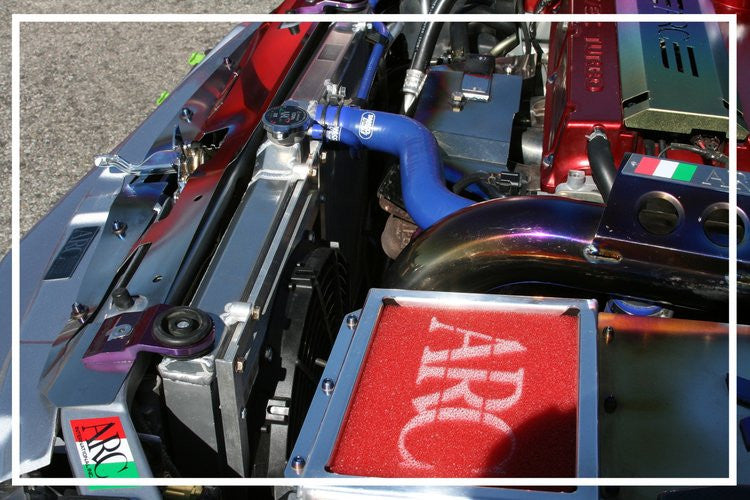
UPGRADED PERFORMANCE RACING RADIATORS
Share
UPGRADED PERFORMANCE RACING RADIATORS
By Jean Genibrel 01-22-2023
RACING COOLING SYSTEMS

To produce maximum performance pick up the airflow from the grill area where the highest pressure location resides on a car or truck.
WATER TEMPERATURE MINUS AIR TEMPERATURE EQUAL ENGINE COOLING
When you pick up the airflow from the grill area you capture the highest pressure location on a car or truck, and with proper ducting to the radiator, it provides maximum performance. Without a duct, the pressure builds in front of the radiator, and it spills over around the radiator into the engine area. This dynamic spoils the internal aerodynamics, increasing lift and drag, and it seriously affects cooling.
CARE OF RADIATORS
Paint acts as a thermal barrier to heat. Keep aluminum radiators unpainted and clean of debris and dirt for the best results.
- Keep the fins of the radiator straight to avoid blocking the airflow. Fin combs are available from radiator shops or C&R Racing.
- With racing and performance engines, it is best not to use any “antifreeze and summer coolant.” Antifreeze helps prevent the water from freezing but does not help cool the water. In fact, antifreeze increases water temps. The product is very viscous, and it increases the surface tension of the cooling medium which reduces the flow of the coolant in the system.
- If you race on pavement, your association probably does not allow you to use antifreeze or other forms of glycol coolants. With these products, a simple leak can slick down the track and create an ideal condition for a wreck.

Some modern upgraded aluminum radiators use extruded tubes that run the full width of the radiator. This improvement permits the water to swirl inside the tubes and rejects maximum amount of het to the radiator fins.

Do not paint heat exchangers. The paint acts as a thermal barrier. No, the color black does not help to radiate heat.

Radiator fin combs come in a variety of shapes. They fit most fin spacing. A fin comb can make a great addition to the race toolbox.
KEEP IT DRY WHEN NOT IN USE
- If you installed a new radiator and decided to remove it for storage, dry it off inside and out to prevent corrosion. When a radiator has been used for a few weeks it will not suffer from corrosion.
- Always protect both sides of a radiator with thin plywood when not racing. Those planks also help to bring the temps up more rapidly before going out on the track. Of course, remember to remove the plywood before racing.

Stant Racing Division manufactures high-pressure radiator caps that go up to 31 PSI.
- It all works together. As such, the flow from the water pump must be up to the task. Purpose-built water pumps, like those produced by Edelbrock Inc., pump about twice the volume of stock water pumps without cavitating. As the flow increases, so does the pressure within the radiator and the heat rejection. Higher flow rates witness better heat rejection, particularly with double-pass core configuration radiators.

Appliedspeed.com offers Edelbrock racing/performance water pumps that improve flow and eliminate cavitation. Do not attempt to race with a stock water pump as it leads to overheating and possibly severe other engine troubles. Further, trying to tow a heavy trailer with a stock water pump is asking for trouble.
- Create the most significant difference in temperature possible between the water in the radiator and the ambient air. The radiator exchanges heat with the ambient air; the more significant the difference between the two, the more heat the radiator rejects.
- The radiator core must be fed with plenty of ambient air. See sections on radiator ducts and fans.
- To protect the engine from possible detonation, overheating, and catastrophic failure, build a system that can allow the pressure to rise as high as necessary without the cap releasing pressure.
- Use the type of water suggested by the radiator manufacturer, and when using antifreeze, always follow the manufacturer’s recommendation or use the pre-mix. When running straight water, use tap water as it contains minerals that prevent ionization of the aluminum in the radiator.

Always mount radiators and coolers on soft rubber. When solidly mounted, the vibrations eventually cause cracks, and failure ensues.
- Do not ground radiators. Instead make sure all the electrical components, the engine, transmission and rear-end are adequately grounded. If the radiator is grounded it acts as a battery and it eats itself up.
- Do double-pass radiators really help cooling? Our racer customers often ask this question. This question is usually asked by guys whose cars are running on the hot side or overheating, and the problem is usually caused by a bad water pump, thermostat, or other problem. Here is a typical inquiry we received on our website and our answer:
Take a look at the other posts on this site for proper care of radiators. If you run straight water for racing make sure there is plenty of pressure in the system to avoid boiling and corrosion.

Ron Davis Radiators supply this Master Grounding kit. The kit is intended to ground all the electrical components as well as the transmission, differential, and engine to prevent electrolysis which can lead to galvanization in the radiator.


